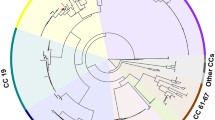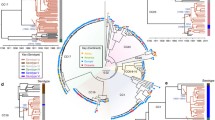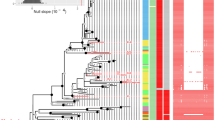Abstract
Streptococcus agalactiae or Group B streptococci (GBS) are a common cause of serious diseases of newborns and adults. GBS pathogenicity largely depends on genes located on the accessory genome including several pathogenicity islands (PAI). The present paper is focused on the structure and molecular epidemiological analysis of one of the GBS pathogenicity islands—the pathogenicity island PAI XII (Glaser et al. Mol Microbiol 45(6):1499–1513, 2002). This PAI was found to be composed of three different mobile genetic elements: a composite transposon (PAI-C), a genomic islet (PAI-B), and a pathogenicity island associated with gene sspB1 (PAI-A). PAI-A in GBS has a homolog——PAI-A1 with similar, but a different genetic constellation. PCR-based analysis of GBS collections from different countries revealed that a strains lineage with PAI-A is less common than PAI-A1 and was determined to be present only among the strains obtained from Russia. Our results suggest that PAI-A and PAI-A1 have the same progenitor, which evolved independently and appeared in the GBS genome as separate genetic events. Results of this study reflect specific geographical distribution of the GBS strains with the mobile genetic element under study.





Similar content being viewed by others
References
Brochet M, Couvé E, Glaser P et al (2008) Integrative conjugative elements and related elements are major contributors to the genome diversity of Streptococcus agalactiae. J Bacteriol 190(20):6913–6917
Cheng HL, Lin WC, Shih PY et al (2013) Streptococcus agalactiae Infective endocarditis with large vegetation in a patient with underlying protein S deficiency. Infection 41(1):247–250
Chmouryguina I, Suvorov A, Ferrieri P et al (1996) Conservation of the C5a peptidase genes in group a and B streptococci. Infect Immun 64(7):2387–2390
Cleary PP, Handley J, Suvorov AN et al (1992) Similarity between the group B and a streptococcal C5a peptidase genes. Infect Immun 60(10):4239–4244
Dmitriev A, Tkáciková L, Suvorov A et al (1999) Comparative genetic study of group B streptococcal strains of human and bovine origin. Folia Microbiol (Praha) 44(4):449–453
Enyeart PJ, Mohr G, Ellington AD et al (2014) Biotechnological applications of mobile group II introns and their reverse transcriptases: gene targeting, RNA-seq, and non-coding RNA analysis. Mob DNA 5:2
Flechard M, Gilot P (2014) Physiological impact of transposable elements encoding DDE transposases in the environmental adaptation of Streptococcus agalactiae. Microbiology 160(Pt7):1298–1315
Florindo C, Gomes JP, Rato MG et al (2011) Molecular epidemiology of group B streptococcal meningitis in children beyond the neonatal period from Angola. J Med Microbiol 60:1276–1280
Florindo C, Damião V, Silvestre I et al (2014) Epidemiological surveillance of colonising group B Streptococcus epidemiology in the Lisbon and Tagus Valley regions, Portugal (2005 to 2012): emergence of a new epidemic type IV/clonal complex 17 clone. Euro Surveill 19(23):1–5
Glaser P, Rusniok C, Buchrieser C et al (2002) Genome sequence of Streptococcus agalactiae, a pathogen causing invasive neonatal disease. Mol Microbiol 45(6):1499–1513
Hacker J, Bender L, Ott M et al (1997) Pathogenicity islands of virulent bacteria: structure, function and impact on microbial evolution. Mol Microbiol 23(6):1089–1097
He J, Baldini RL, Deziel E et al (2004) The broad host range pathogen Pseudomonas aeruginosa strain PA14 carries two pathogenicity islands harboring plant and animal virulence genes. Proc Natl Acad Sci U S A 101(8):2530–2535
Herbert MA, Beveridge CJE, McCormick D et al (2005) Genetic islands of Streptococcus agalactiae strains NEM316 and 2603VR and their presence in other group B streptococcal strains. BMC Microbiol 5(31):1–13
Kasimatis G, Fitz-Gibbon S, Tomida S et al (2013) Analysis of complete genomes of Propionibacterium acnes reveals a novel plasmid and increased pseudogenes in an acne associated strain. Biomed Res Int 2013:1–11
Kramskaya TA, Leontyeva GF, Grabovskaya KB et al (2014) Analysis of protective activity of polyvalent group В streptococcal recombinant vaccine based on conserved surface proteins. Medical Alphabet 3(16):7–10
Kuleshevich EV, Savicheva AM, Arzhanova ON et al (2013) Distribution and genetic organization of pathogenicity island XII among the clinical strains of GBS. Mol Genet Microbiol Virol 28(1):15–19
Li M, Shen X, Yan J et al (2011) GI-type T4SS-mediated horizontal transfer of the 89K pathogenicity island in epidemic Streptococcus suis serotype 2. Mol Microbiol 79(6):1670–1683
Martins ER, Florindo C, Martins F et al (2007) Streptococcus agalactiae Serotype Ib as an agent of meningitis in two adult nonpregnant women. J Clin Microbiol 45(11):3850–3852
Poyart C, Tazi A, Reglier-Poupet H et al (2007) Multiplex PCR assay for rapid and accurate capsular typing of group B streptococci. J Clin Microbiol 45(6):1985–1988
Richards VP, Lang P, Bitar PD et al (2011) Comparative genomics and the role of lateral gene transfer in the evolution of bovine adapted Streptococcus agalactiae. Infect Genet Evol 11(6):1263–1275
Suvorov AN, Ferretti JJ (2004) Construction of a GBS-GAS DNA subtraction library allows discovery of previously unidentified GBS genes and rapid location of unique regions on the GBS chromosome. J Basic Microbiol 44:66–74
Suvorov A, Grabovskaja K, Savicheva A et al (2006) Determination of group B streptococcal genes encoding putative adherence factors in GBS clinical strains. Int Congr Ser 1289:227–230
Tettelin H, Masignani V, Cieslewicz MJ et al (2002) Complete genome sequence and comparative genomic analysis of an emerging human pathogen, serotype V Streptococcus agalactiae. Proc Natl Acad Sci U S A 17(99):12391–12396
Zhang W, Rong C, Chen C et al (2012) Type-IVC secretion system: a novel subclass of type IV secretion system (T4SS) common existing in gram-positive genus Streptococcus. PLoS One 7(10):1–7
Acknowledgements
This work was supported by the following projects: (i) State contract of Russian Federation 14N08.12.0003; (ii) NANO_GUARD, fullerene-based systems for oxidative inactivation of airborne microbial pathogens (Project No: 269138. FP7-MC-IRSES); and (iii) UCIBIO (UID/Multi/04378/2013 and POCI-01-0145-FEDER-007728) and Project PTDC/CVT-EPI/6685/2014, funded by Fundação para a Ciência e a Tecnologia, Portugal. Natesan Balasubramanian was supported by research grant ref. SFRH/BPT/91219/2012 from Fundacão para a Ciência e Tecnologia, Portugal.
Author information
Authors and Affiliations
Corresponding author
Rights and permissions
About this article
Cite this article
Kuleshevich, E., Ferretti, J., Santos Sanches, I. et al. Clinical strains of Streptococcus agalactiae carry two different variants of pathogenicity island XII. Folia Microbiol 62, 393–399 (2017). https://doi.org/10.1007/s12223-017-0509-8
Received:
Accepted:
Published:
Issue Date:
DOI: https://doi.org/10.1007/s12223-017-0509-8




